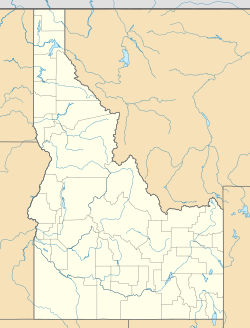The Twin Falls Downtown Historic District is a 20 acres (8.1 ha) historic district in Twin Falls, Idaho which was listed on the National Register of Historic Places in 2000.
Twin Falls Downtown Historic District | |
 Orpheum Theater, built 1920 | |
| Location | Roughly bounded by 2 Ave. N, 2 St. E, 2 St. W, 2 St. S, 3 Ave. S, 3 St. W., Twin Falls, Idaho |
|---|---|
| Area | 20 acres (8.1 ha) |
| Architect | Morse, Burton; et.al. |
| Architectural style | Classical Revival, Art Deco |
| NRHP reference No. | 00000035[1] |
| Added to NRHP | February 4, 2000 |
The 20 acres (8.1 ha) district spans 11 blocks of mostly commercial buildings, and included 42 contributing buildings and 33 non-contributing ones.[1][2]
It includes works by local architects Burton Morse and Ernest Gates, and by other architects including J.H. Dodd, Houghtelling and Vissner, C. Harvey Smith, and Boise firm Wayland & Fennell.[2]
Selected buildings include:
- Twin Falls Title and Abstract building, 202 E. Shoshone, whose main portion, with Classical Revival details, was designed by Burton Morse in 1917
- Herriott Motor Building (c.1917), 156 Second Avenue W., designed by Burton Morse. It became an auto dealership, the location of local radio station KTFI from 1932 to 1937, a ballroom named "Radioland", and during the 1940s was the Rollerdome skating rink.[2]
- Baugh Building (1916), 102 Main Avenue N., a two-story building with a cornice, having a corner entrance and also an entry on Shoshone Street N. This was designed by Wayland & Fennell.[2]
References
edit- ^ a b "National Register Information System". National Register of Historic Places. National Park Service. July 9, 2010.
- ^ a b c d Elizabeth Egleston Giraud (June 15, 1999). "National Register of Historic Places Registration: Twin Falls Downtown Historic District". National Park Service. Retrieved October 13, 2017. With 24 photos.
Wikimedia Commons has media related to Twin Falls Downtown Historic District.

